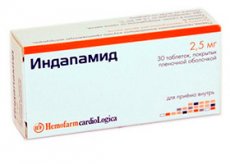Medical expert of the article
New publications
Preparations
Indapamide
Last reviewed: 03.07.2025

All iLive content is medically reviewed or fact checked to ensure as much factual accuracy as possible.
We have strict sourcing guidelines and only link to reputable media sites, academic research institutions and, whenever possible, medically peer reviewed studies. Note that the numbers in parentheses ([1], [2], etc.) are clickable links to these studies.
If you feel that any of our content is inaccurate, out-of-date, or otherwise questionable, please select it and press Ctrl + Enter.

Indications Indapamide
It is used to reduce high blood pressure.
Such forms of drugs as Indapamide Teva, Indapamide Retard, as well as Indapamide MV Stada and others are used to treat CHF and hypertension of moderate severity.
Release form
The drug is produced in tablets of 1.5 mg (Indapamide MV Stada and Indapamide Retard), 2.5 mg (Indapamide) and capsules of 2.5 mg (Indapamide Verte).
Packing: 10 pieces inside a blister plate. There are 3 such plates in a box.
 [ 7 ]
[ 7 ]
Pharmacodynamics
The medicinal properties of the drug are similar to the mechanism of action of thiazide-type diuretics. Indapamide increases the values of chlorine, sodium ions, potassium, and magnesium in the urine. In addition, it increases the elasticity of arterial membranes and gently reduces the resistance of peripheral vessels. It does not affect blood lipid levels and carbohydrate metabolism. It helps reduce left ventricular hypertrophy.
The drug stimulates the production of PG E2, and also has a significant effect on the production of free oxygen radicals.
Pharmacokinetics
The medicinal effect develops half an hour after consumption (with the bioavailability level being approximately 93%) and lasts for 24 hours. Peak values in the blood are observed 12 hours after the tablet dissolves in the gastrointestinal tract.
The half-life of the substance is 18 hours. Eating food may slightly increase the absorption period, but the absorption of the drug remains complete.
Up to 80% of drugs are excreted through the kidneys in the form of metabolic products, and about 20% through the intestines.
Dosing and administration
The medicine is used strictly according to the instructions - one dose per day (recommended in the morning), in the amount of 1 capsule or tablet.
The medication can be combined with other antihypertensive drugs, but only the attending physician can select a regimen for such combinations.
It should be noted that Indapamide in the form of Retard has a longer and at the same time softer effect of the reagent - this is due to the fact that the release of the active element of the drug occurs with a delay.
The duration of use of the drug is determined by the doctor, taking into account the degree of hypertension. It should be noted that in medical practice, the drug is classified as a medication prescribed for long-term use (sometimes throughout life).
Use Indapamide during pregnancy
Prescribing Indapamide to pregnant women is prohibited.
Contraindications
Main contraindications:
- presence of liver or kidney failure;
- allergy to sulfonamide derivatives;
- diabetes mellitus or anuria;
- breastfeeding women;
- pre-infarction condition.
 [ 16 ]
[ 16 ]
Side effects Indapamide
As a diuretic drug, Indapamide can reduce serum calcium levels and sodium levels, causing dehydration. This can lead to side effects such as headaches, constipation, allergic reactions, nausea, and dry mouth.
Occasionally, the development of hemolytic anemia and heart rhythm disorders are noted.
Overdose
Poisoning with the drug occurs when a dose of 40 mg is consumed. Intoxication is expressed in the form of nausea, dry mouth, a feeling of drowsiness, vomiting and a sharp decrease in blood pressure.
In case of an overdose, it is necessary to take emergency measures - wash the patient's stomach, restore the electrolyte balance and perform rehydration (performed exclusively in a hospital).
 [ 25 ]
[ 25 ]
Interactions with other drugs
Combination with neuroleptics or antidepressants potentiates the antihypertensive effect of the drug and also increases the risk of orthostatic collapse.
CG, auretics and laxatives potentiate the likelihood of developing potassium deficiency. When combined with erythromycin, tachycardia may develop, accompanied by ventricular fibrillation. GCS and NSAIDs reduce the antihypertensive effect of Indapamide. Iodine-containing drugs can cause dehydration. Combination with cyclosporine leads to the development of hypercreatininemia.
Application for children
The medication is not prescribed to persons under 18 years of age.
Analogues
The following drugs are analogs of the drug: Lorvas, Oxodolin, Indapen with Acrylamide, as well as Cyclomethiazide, Hydrochlorothiazide and Indopres.
 [ 33 ], [ 34 ], [ 35 ], [ 36 ], [ 37 ]
[ 33 ], [ 34 ], [ 35 ], [ 36 ], [ 37 ]
Reviews
Indapamide generally receives good reviews regarding its medicinal effect. Most hypertensive patients tolerate the drug without developing complications. This fact is confirmed by reviews of both patients and doctors and discussions on forums dedicated to the treatment of hypertension.
Negative manifestations develop quite rarely and have a weak degree of expression. Many hypertensive patients use this medicine all their lives.
Attention!
To simplify the perception of information, this instruction for use of the drug "Indapamide" translated and presented in a special form on the basis of the official instructions for medical use of the drug. Before use read the annotation that came directly to medicines.
Description provided for informational purposes and is not a guide to self-healing. The need for this drug, the purpose of the treatment regimen, methods and dose of the drug is determined solely by the attending physician. Self-medication is dangerous for your health.

